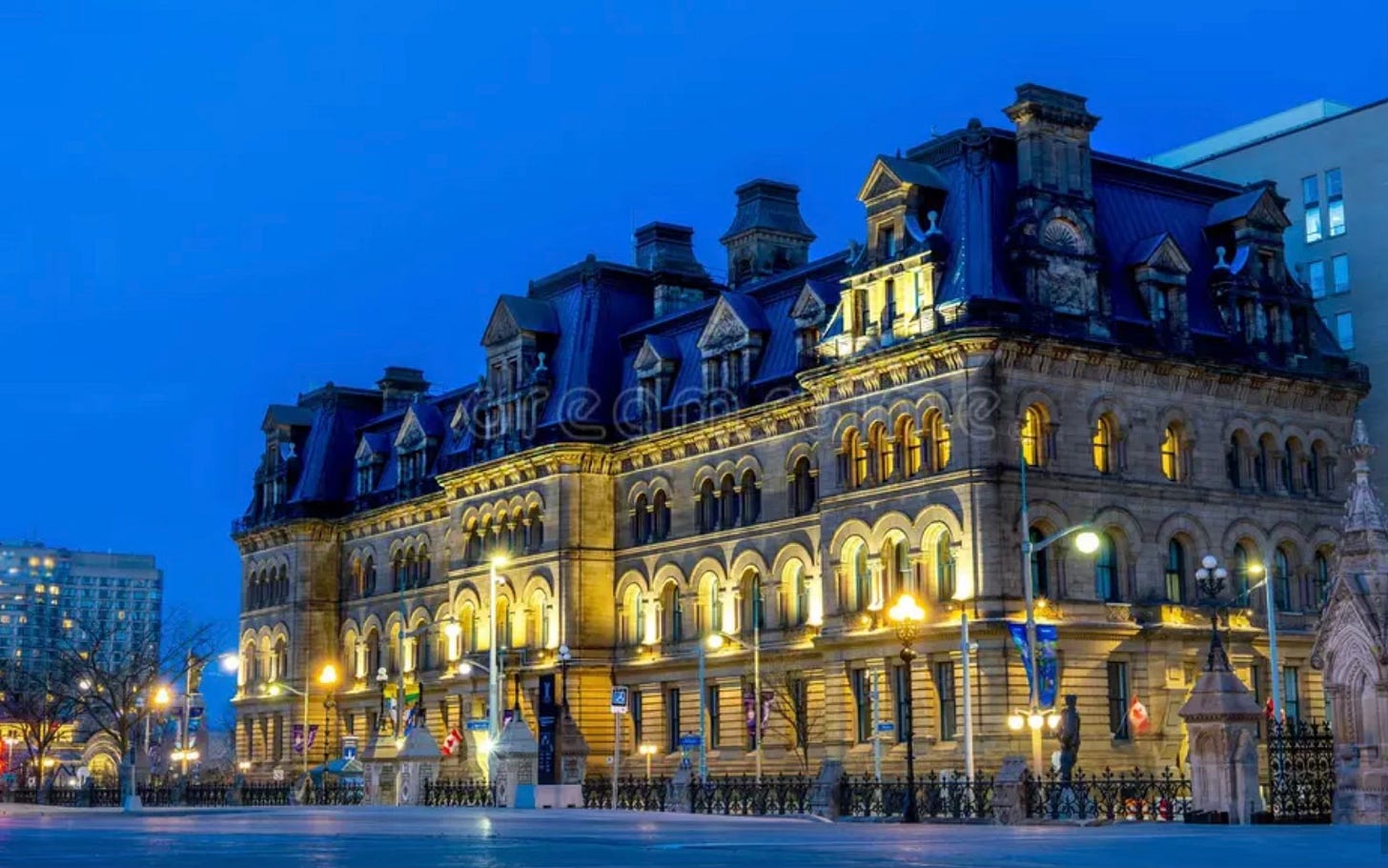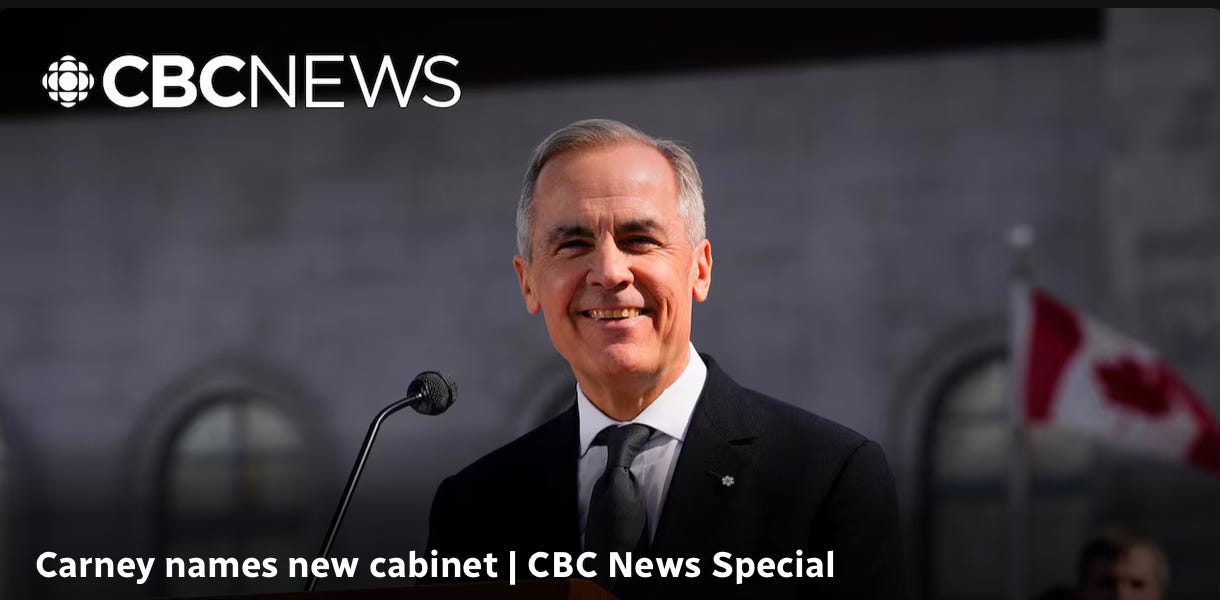Mark Carney’s Canada/Il Canada di Mark Carney
From Central Banker to Prime Minister: Why Canadians Chose Technocracy Over Ideology/Da banchiere centrale a Primo Ministro: perché i canadesi hanno preferito la tecnocrazia all’ideologia
Mark Carney is set to unveil his new cabinet. His unexpected political success—achieved despite his party’s unpopularity—signals a shift in Canadian priorities: less ideology, more pragmatism. Canadians seem to have chosen competence over charisma, and independence over integration with a Trump-led United States (this article, written by Stefano, was published in Italian in the Comments section of the daily newspaper Domani)
This Tuesday, Mark Carney—freshly confirmed as Prime Minister after his April 28 electoral win—will present his new cabinet to Parliament. He will thus succeed himself, after two months at the helm of government following the departure of former Prime Minister Justin Trudeau. His stated goal: to prepare for a political battle aimed at shaping a strong, united Canada, increasingly independent from the United States.
As was the case in the immediate aftermath of the election, many commentators are likely to frame Carney and his government as the liberal answer to a brand of conservatism that’s being increasingly likened to Trumpism—embodied by his electoral rival, Pierre Poilievre.
Without delving into the actual overlap—arguably tenuous—between today’s Canadian Conservatives and the MAGA ideology currently dominating U.S. politics, such a reading risks underestimating (perhaps deliberately) the impact Mark Carney himself had on the choice made by Canadian voters.
Victory in Spite of the Party
To be clear: Carney won the election not thanks to the Liberal Party, but in spite of it—a party that turned to him in a last-ditch effort to stave off collapse. On January 20, when Donald Trump was sworn into the White House, the Liberals—deeply unpopular after a decade of Trudeau governments—were trailing Poilievre’s Conservatives by 25 points in the polls. That they ended election night on April 28 with a three-point lead in the popular vote is due almost entirely to the fact that they were led by a man who is anything but a typical politician.
The credibility many Canadians have granted him as the best antidote to Trump’s aggressive posturing toward Canada stems from his identity as a technocrat—pragmatic, focused, and armed with an agenda built around “Build, baby, build” – a phrase that, at least rhetorically, closely echoes the Trumpian “Drill, baby, drill.”
A Post-Ideological Pitch with Real-World Credentials
What convinced nearly half of the electorate were his two terms as a central banker: first in Canada—appointed, notably, by Conservative Prime Minister Stephen Harper—during the 2008 financial crisis, and then in the United Kingdom, steering through the turbulent waters of Brexit. Also pivotal was his post-ideological approach to policy, worlds apart from the “Sunny ways” optimism and the fanciful promises—like budgets balancing themselves—that had characterized his predecessor Trudeau’s style and governance. Equally persuasive was his pledge to build relentlessly: homes, because the ones currently available are increasingly out of reach for the average Canadian; and infrastructure—primarily pipelines and “energy corridors”—to unlock the country’s economic potential and reduce its increasingly risky dependence on U.S. economic integration, which has begun to threaten Canada’s very autonomy.
Shadows Behind the Spotlight
It is on the strength of these credentials—decidedly non-political, at least in the traditional sense of the word—that Canadians were willing to overlook aspects of Carney’s background that cast more than a few shadows. Among them: his role as part of the economic advisory team in the final Trudeau government—though likely a sidelined voice, given his predecessor’s ideological dominance; his seat on the board of Brookfield Asset Management, an investment firm whose stated focus is on renewable energy but which has made significant investments in fossil fuel ventures—and whose headquarters were relocated from Toronto to New York while Carney was serving as Chair (not exactly ideal optics for someone positioning himself as Canada’s bulwark against U.S. influence); and finally, the fact that, although he did transfer his substantial financial assets into a blind trust upon becoming Prime Minister, he has never disclosed their scale—despite repeated calls from political opponents and media commentators.
Italy, Take Note: The Carney-Draghi Parallel
In other words, voters made a choice—at least for now—to prioritise pragmatism and concrete solutions over lofty ideals and idealism. This doesn’t mean Canadians have abandoned a political vision for society, but for the moment, as the saying goes, primum vivere. In this sense, one should be very cautious in framing Carney’s rise as a straightforward political response to Trumpism—especially in a country like Italy, which has already had its own version of Carney, also a former Goldman Sachs figure: Mario Draghi. The difference being that, if Draghi were to run for office, he would never come close to winning 43% of the vote.

Il Canada di Mark Carney
Mark Carney, appena confermato Primo Ministro dopo la vittoria elettorale del 28 aprile, si prepara a presentare il suo nuovo governo. Il suo inaspettato successo politico — ottenuto nonostante l’impopolarità del suo partito — segna un cambio di rotta nelle priorità dei canadesi: meno ideologia, più pragmatismo. I cittadini sembrano aver scelto la competenza al posto del carisma, e l’indipendenza rispetto a una sempre più stretta integrazione con gli Stati Uniti guidati da Trump
La versione italiana dell’articolo è stata pubblicata sul quotidiano “Domani”, diretto da Emiliano Fittipaldi.





